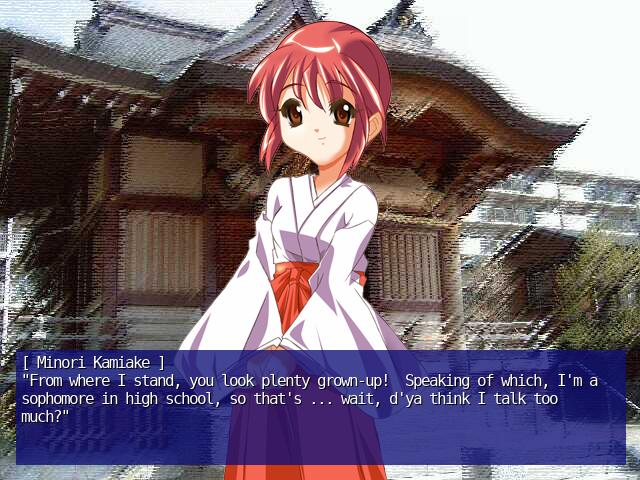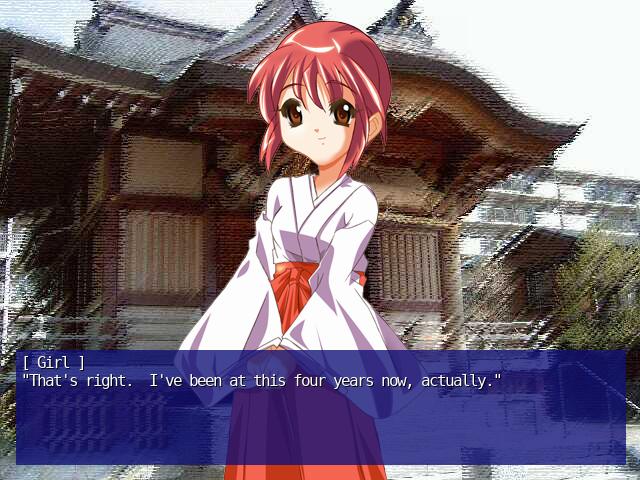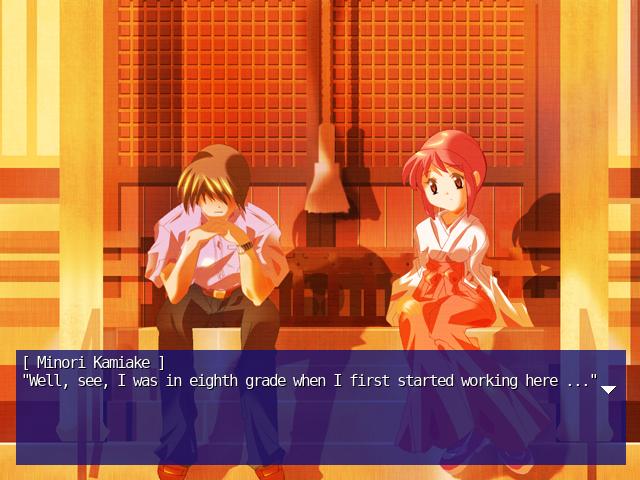While working on my comprehensive analysis of the story in May Sky, Insani’s 2008 localization of a 2005 freeware doujin Japanese visual novel, I came across an interesting translation point while reviewing the script – which I converted from the novel’s text file into a PDF that I could annotate in Zotero. Before continuing, do note that I cannot read Japanese, so I am examining the localization on its own English-language terms.
May Sky centers on two characters. The primary view-point character is a 22-year old salary-man named Haruki Mizoguchi. His main interlocutor is Minori Kamiake, a high school student who works part-time as a shrine maiden at a shrine where her Aunt is head priestess. Note that I left the particulars of Minori life as a high school student vague – for that is the subject we are concerned with today.
Whenever I write about media that involves Japanese high schools, I make sure to note for the benefit of most of our readers (being an American website and all) that Japanese senior high schools cover three years – 10th through 12th grades – instead of the four years covered by U.S. high schools. For this reason, I usually describe the year of fictional Japanese high school students using a grade number (since that is transferable) or with the reminder that, for example, “second year” high school student in Japan is equivalent to our 11th grade instead of 10th. I avoid using “freshman,” “sophomore,” and “junior” because I think doing so would invite confusion for people who are not familiar with the three-year high school scheme. Technically speaking, freshman and sophomore mean first-year and second-year, but mapping those terms to Japanese high school students requires knowing the duration of high school in Japan – something that I do not presuppose all of my readers know. I am comfortable using “senior” because that maps to the same final grade level in both Japan and the United States.
Now let us return to Minori, and specifically to an early scene where she and Haruki are getting to know each other. See the following quote:
“Speaking of which, I’m a sophomore in high school…”

An American reader who is unfamiliar with the grades covered by high school in Japan may come away from this line in isolation with the impression that Minori is a 10th grader. Insani, the circle which handled the May Sky localization (specifically Irene Ying working under the editorial supervision of Seung Park), emphasize that they understand localization to be distinct from rote word-for-word translating (see Mr. Park’s very insightful translation review). I immediately understood that Insani was not taking localization liberty here – Minori is clearly saying that she is an 11th grade student in four-year high school terms. The expert team at Insani certainly knew the precise definition of sophomore as conveying the second year of the three years of senior high school in Japan, just as it is the second year of the four years in the United States.
(I will add that the script previously used the word freshman where Haruki is describing “freshman blues” experienced by new corporate employees, where freshman is referring to first-year workers. Mr. Park explained that this was Insani’s translation of “May sickness,” a term which only makes sense in the the Japanese context where the school year begins and ends in April. But that aside – the use of freshman at all indicates that had Minori been a first year high school student, Insani would have certainly opted for freshman instead of sophomore.)
With that being said – I do not like the use of sophomore here, even if it is the most natural conversational way of Minori describing her year as a student. Its meaning is only clear if you presuppose that whoever is reading it understands that Japan has a three-year high school system. Moreover, Minori’s age is a significant point in May Sky. Had Haruki, a 22-year old salary man, been ambiguous to some readers about whether some past event happened when he was a 10th or 11th grader, it would have most likely hardly been worth noting. Minori, however, is a high school student in the present and the particular place she is in her life is important to understanding her character and interactions with Haruki.
A very careful reader would actually be able to pin down from the script alone that Minori means 11th grade when she says sophomore – but I am saying that based on reading the script as a PDF, which is not how the ordinary reader would (or should, for that matter) interact with the visual novel. In order to define “sophomore” using the script, we have to first turn backward in the script, about a page and a half earlier than the sophomore line.
“I’ve been [working here] four years now, actually.”
Minori had previously revealed that she had been working as a part-time shrine maiden for four years. Thus, she was working four years before becoming a sophomore in high school. I say becoming because the Japanese school year starts in April, another point that some readers of the novel may not be familiar with.
Now let us skip down further in the script. On my PDF we need to skip 24 pages from the sophomore line and 26 from the four-year line to reach the next important quote. While this is still early in the grand scheme of the novel (my PDF is 196 pages), this is a decent amount of reading for someone enjoying the original work. I quote Minori:
“Well, see, I was in eighth grade when I first started working here …”
Eureka! Minori started working at the shrine when she was in eighth grade. She worked continuously at the shrine for four years and she is now a sophomore. The math works out: Minori is in eleventh grade.
However, the problem remains – a reader who is (A) reading the visual novel normally and (B) does not know that Japanese high school is three years (much less that the year starts in April) is unlikely to piece the two additional pieces of evidence together and deduce that sophomore Minori is an 11th grader at the start of May Sky. The script is not ambiguous on its own terms, and Minori’s “sophomore” line is not technically ambiguous, but the overall effect is ambiguous to an American reader without having knowledge beyond the scope of May Sky.
To be sure, the vast majority of people playing the al|together novels are likely familiar with how high school works in Japan. I have a different interest in the issue. In reviewing the novels, I hoped to not only bring attention to some worthy, under-appreciated projects (noting that May Sky is my favorite of the 31 al|together novels), but also to encourage some people who are not familiar with visual novels at all to give some a try. Because I am writing for an audience beyond core Japanese visual novel fans, I take note of little issues that may be confusing to a broader English-speaking demographic, especially here in the United States.
Thus, I conclude with my two cents on how Japanese-language games referencing Japanese high schools and junior high schools should be handled, notwithstanding the fact I cannot read Japanese. Assuming arguendo the goal is to mitigate potential confusion for American readers or readers from countries with 4-year high schools, I advocate either:
- Using grade numbers instead of class names except in the case of seniors, since “senior” corresponds to 12th grade in all K-12 cases; or
- Adding a note, elegantly within the script or as an aside, clarifying the three-year high school system.
Point 1 may be inadequate in the case of 8th, 9th, and 10th grades. In America at least, 8th grade is the last year of junior high school – a senior so to speak (your humble editor was class salutatorian – not to brag). But in Japan, the 8th graders have seniors. Similarly, using 9th and 10th grade alone is lacking context since 9th grader is junior high school in Japan but high school in four-year high school systems, and 10th graders are high school freshmen in Japan but sophomores in the United States. I have found that anime centered on high schools where classes are issues tend to make indirectly clear at one point or another that there are just three grades – but in a novel such as May Sky where age is significant but high school exists only in the background, a more targeted definition should be used.
(Note: I mention an ambiguity about when Minori moved from the country-side relative to her schooling that pops up late in May Sky in the final part of my four-part analysis.)
This article is part of my collection of posts about May Sky, Insani's 2008 localization of a freeware Japanese visual novel called Gogatsu no Sora.

